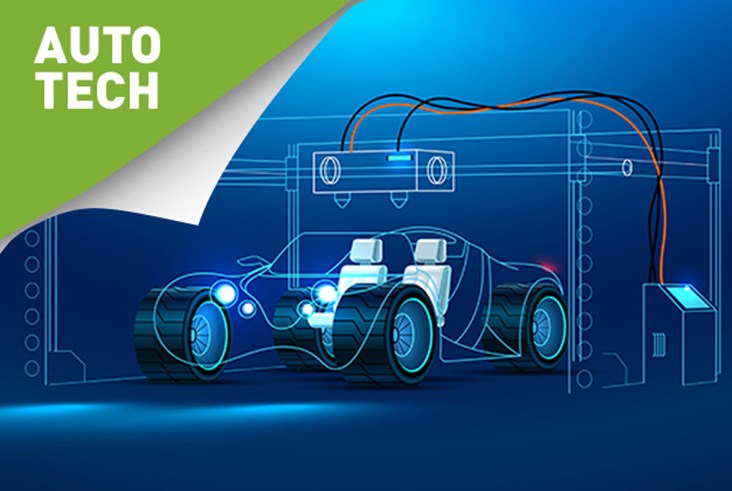How 3D Printing will Revolutionize The Automotive Industry
Back
Additive Manufacturing (AM) refers to the process of building 3D objects by adding layer-upon-layer of material - whether plastic, metal, or concrete. Over the past decade, AM has significantly transformed design, development and manufacturing processes. For the automotive industry, these technologies have been disruptive, allowing for the manufacturing of lighter and more complex structures at lower costs. Access to new materials, customizable finishes and shorter lead-times have encouraged automakers to integrate 3D printing in their manufacturing process. Being one of the most competitive industries worldwide, automakers need to continuously innovate in order to stay ahead of competitors. 3D printing provides a strong factor of differentiation for two main reasons: it allows for faster product innovation and design in addition to transforming the supply chain and cutting costs.
Since its introduction, 3D printing is mainly used for rapid prototyping. However, the rapid development of additive manufacturing technology in recent years has allowed for numerous 3D printing applications:
Supercars and Formula 1
The numerous advantages AM offers has led both F1 teams and supercar manufacturers to start making extensive use of the technology.
For every F1 race, adjustments need to be made and parts have to be produced on demand. AM technologies allow F1 teams to build parts faster, stronger and lighter. These race-ready parts take days and vast amounts of money to produce, with 3D printing, they are ready within hours. F1 teams have therefore leveraged the technology to print performance, aerodynamic and repair parts for gearbox assemblies, rear wings and bodywork.
Similar to Formula 1, supercar manufacturers continuously focus on reducing three things: lead time, costs and vehicle weight. Lamborghini, along with its partner Stratasys (a leader in AM technology), was able to produce 3D printed parts for their Aventador’s aesthetic functions and performance. Stratasys claims that developing these parts with traditional manufacturing would have cost $40,000 and 120 days while 3D printing brought total costs down to $3,000 and 20 days, resulting in significant cost savings and reductions in lead time. Koenigsegg, which has established a reputation for producing the most technically advanced hypercars on the planet, has also made extensive use of AM technology to produce their lightweight One:1 hypercar. Take a look at how they’ve used 3D printing in their design and manufacturing process:
3D Printed Cars
One of the first to ever produce a fully 3D printed car is Local Motors with their “LM3D”. The electric car is made up of 80% ABS plastic and 20% Carbon Fiber. The plastic is reinforced with carbon fiber, which applies to the chassis/frame, exterior body, and some interior features. The mechanical components such as the battery, motors, wiring, and suspension, are all sourced from Renault’s Twizy. The LM3D is light, yet as strong as any traditional car, and Local Motors claims it’s completely road legal. The LM3D will be produced at additive manufacturing micro-factories around the world, capable of pumping out 250 customized cars a year with zero material waste. These cars will cost around $53,000 and Local Motors claims buyers will be able to go online, customize their car and have it 3D printed in just 44 hours.

3D Printed Prototypes
The main attraction of AM for automakers is not the printing of vehicles but rapid AM prototyping. 3D printing has penetrated automotive prototyping by about 15% to 20% so far and one of the automakers that have adopted the technology is Ford Motors. Ford has been able to decrease prototyping design time and cost, enabling them to experiment with plenty of different designs for its all-new Ford GT and Ford Fusion. Designers employed 3D printing to evaluate both exterior and interior design cues before finalizing designs, without consuming time and money. Ford even plans to make further use of the technology stating that “3D printing can deliver prototypes in a matter of hours, enabling designers and engineers to quickly test and refine new designs and innovations – sometimes hundreds of times”.

3D Printed Spare Parts
Spare parts are a huge topic for any industry disrupted by 3D printing. Being able to cut down the supply chain and produce parts on-demand, closer to the customer is the dream of any business. Commercial automakers like Audi, for instance, thrive to achieve economies of scale when adopting 3D printing. Audi is using AM technology in a variety of ways, but by starting to 3D print its spare parts, it has enjoyed significant savings. Automakers keep vast stocks of spare parts that have to be shipped around the globe, which remain idle for years. With strategic placement of 3D printers around the globe, however, Audi has managed to eliminate over production of certain parts and is now capable of printing parts on demand, saving vast amounts of money sitting in idle stock. In the future, certified service centers will simply print parts as and when needed, eliminating the time consuming and costly process.

Mass Customization
Customization makes businesses a lot of money in almost every industry and this is certainly true when it comes to the automotive sector. Drivers want their car to look unique and they have no problem paying for this privilege. With 3D printing, automakers can now offer much more unique finishes and touches to customer vehicles while saving time and money. These offerings open up a new profit stream and extend the marketing reach for automakers. 3D printers can produce parts in many shapes and sizes, giving automakers a massive scope when it comes to producing customized automotive parts. Honda and Ford have already started producing custom light surrounds, switchgears, badges and much more. With the cost and time savings involved in 3D printing custom auto parts, expect to see many more automakers adopt the technology in the near future.

AM technology provides much more than just cost cuts, weight reduction and higher profits – 3D printing has numerous advantages and implications for the entire automotive industry:
1. Accelerates Production Time
Additive manufacturing provides an autonomous production process. After designers and engineers feed their CAD files, 3D printing occurs with no human intervention and thus, prevents loss of time due to human limitations.
2. Increases Design Flexibility
3D printing provides endless design possibilities. Automotive manufacturers can develop more customized features, lightweight structures, detailed geometries, and multi-material parts similar to the LM3D’s carbon fiber reinforced plastic.
3. Reduces Risks
3D printing provides manufacturers with more accurate forecasting, capacity planning and delivery timing. Automakers aim to achieve the highest grade of predictability in order to deliver their vehicles and parts on time - AM reduces the risk of storing excess idle stock or even depletion.
4. Eliminates Suppliers
With 3D printing, auto manufacturers can produce at the end of the supply chain and cut out numerous suppliers. Parts no longer have to be assembled through numerous component suppliers; this significantly decreases costs and the dependence on suppliers.
5. Supports Environmental Sustainability
AM technology helps the environment in numerous ways. First of all, materials used for 3D printing are fully recyclable. Second, compared to the traditional process, 3D manufacturing requires a considerably less amount of electricity. Third, automakers drastically reduce their carbon footprint by eliminating the need for trial and error to produce multiple designs. With AM, automakers create designs on a computer, make adjustments and then simply print it.
Conclusion
Additive manufacturing has substantially and irrevocably disrupted the automotive industry in how cars are both designed and developed. Automakers that have adopted 3D printing have improved their product development process in a way that no other technology has. Auto parts produced using AM technology reduce vehicle price tags and provide faster product development, lighter vehicles and custom features. However, like with any form of technology, notable challenges do exist which include:
- Equipment costs
- Lack of expertise and trained human capital
- Inaccuracy from build to build
- Legal issues (AM designs can only be patented, not copyrighted)
- Inability to produce large singular parts
Latest Business
Intelligence Report













